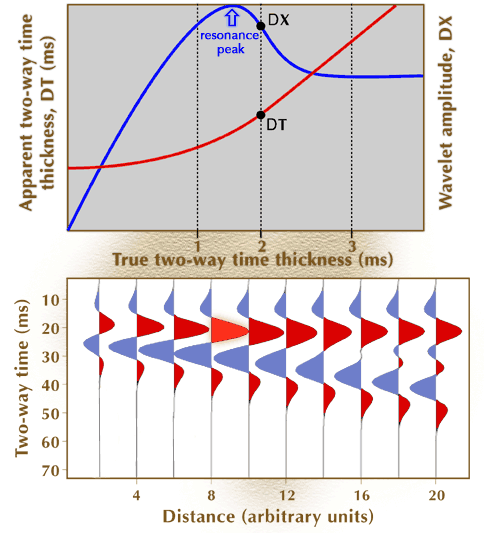 |
 |
| ©2000 AGI |

Three essential points about the seismic reflection process can be concluded from the wedge model results:
1. The timing difference between the first and last troughs of the composite reflection is directly proportional to bed thickness when the one-way traveltime bed thickness exceeds one-fourth the dominant wavelength (that is, when the two-way traveltime thickness exceeds one-half the dominant wavelength). Two-way traveltime bed thicknesses greater than one-half the dominant wavelength can be determined by measuring the time differences between the onset of the R1 (top interface) and R2 (bottom interface) reflection events that combine to make the composite waveform.
2. The shape of the reflected waveform changes very little when the one-way traveltime bed thickness is less than one-fourth the dominant wavelength (or when the two-way traveltime is less than one-half the dominant wavelength). In this thickness range, it is the amplitude of the composite reflection, not a phase change or a timing difference between phase points of that waveform, that is proportional to bed thickness.
3. A constructive interference occurs when the one-way traveltime bed thickness is one-fourth the dominant wavelength (which is a two-way traveltime bed thickness of one-half the dominant wavelength). The composite reflection acquires its largest amplitude for this value of bed thickness. This phenomenon is called thin-bed tuning.
Because
timing differences between phase points (peak extrema, trough extrema,
or zero crossing) of the reflected waveform do not indicate bed thickness
when the vertical dimension of the bed is less than one-fourth the dominant
wavelength in one-way time, interpreters define this one-way traveltime
bed-thickness value (that is, one-fourth the dominant seismic wavelength)
as the onset of the thin-bed regime. The calculated waveshapes in Figure
4 are noise free. In real data, when noise is added and wavelet interpretation
is more difficult, the thin-bed regime is more difficult to define because
noise alters reflection waveshapes and amplitudes in addition to bed
thickness effects.
